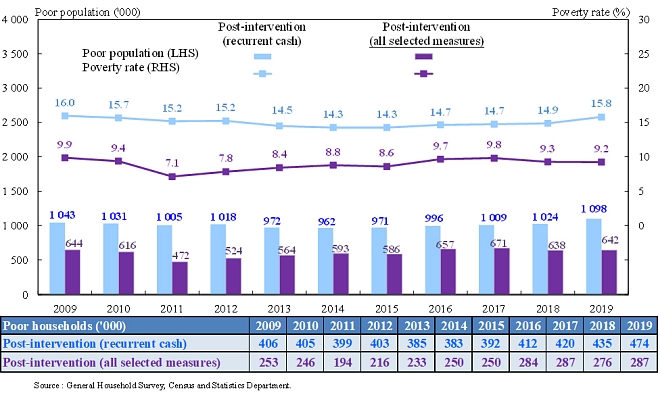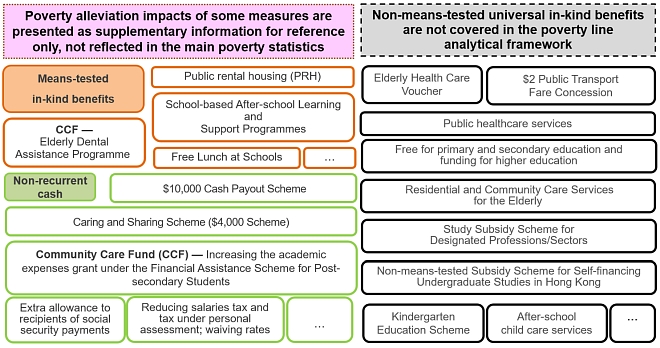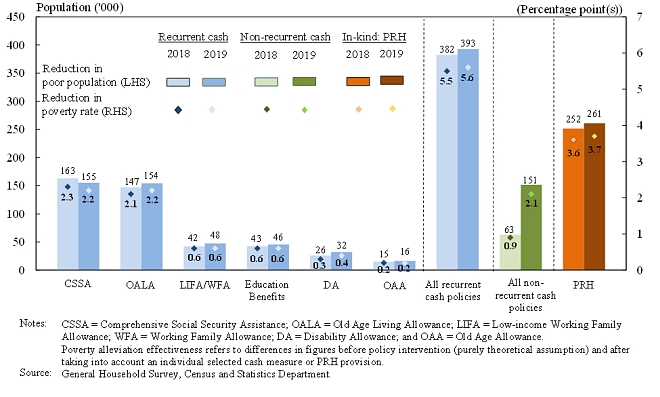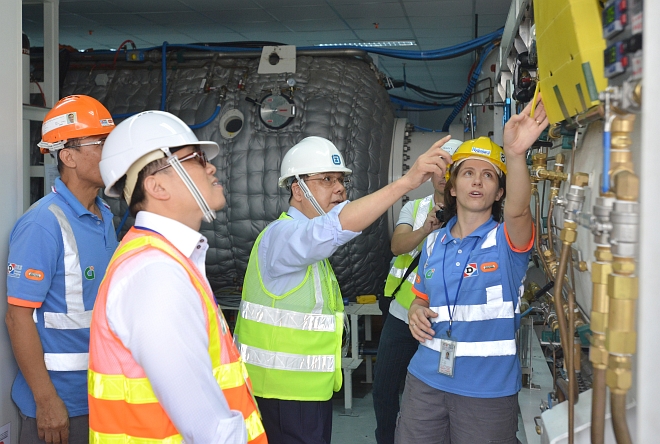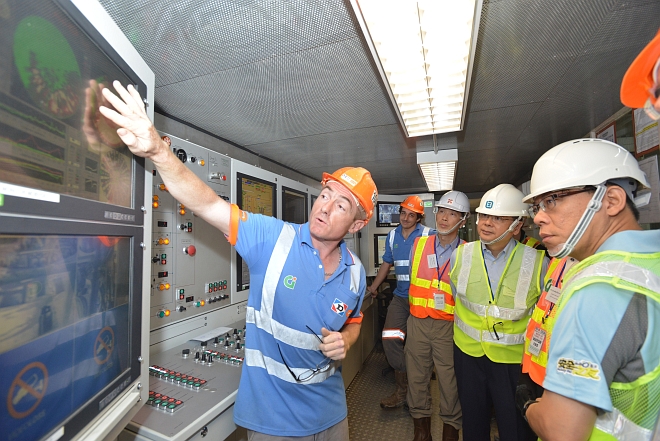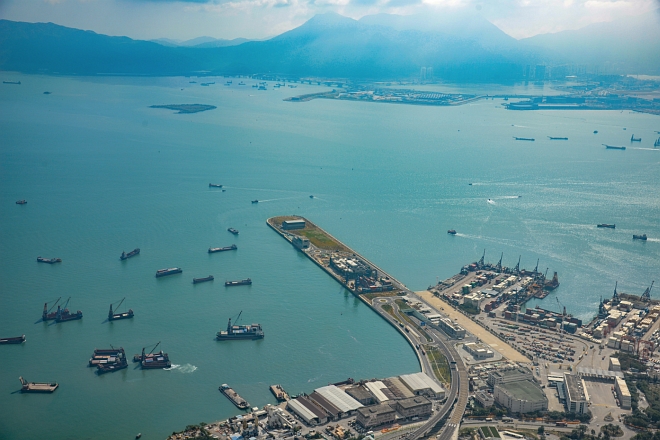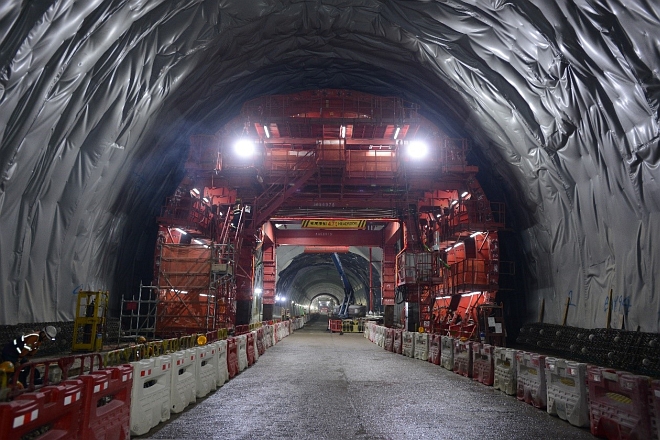Use of COVID-19 vaccines based on science and safety
Objective understanding of poverty line given its limitations
TM-CLK Tunnel opening today showcases Hong Kong's infrastructural strength
27 December 2020
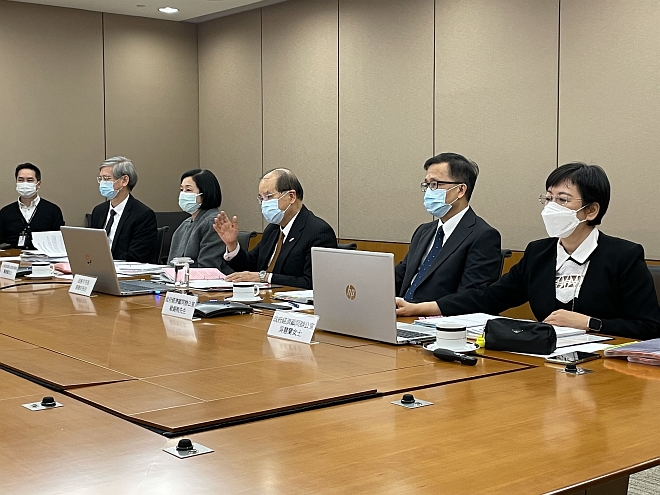
Meeting of the Commission on Poverty (December 23, 2020) |
Looking back at 2020, COVID-19 was by far the most impactful and challenging crisis faced by all humankind. With the epidemic still running rampant across the globe, vaccination is deemed to be one of the most efficacious means to prevent and control the disease.
The Government is striving for the early supply of COVID-19 vaccines to Hong Kong while ensuring their compliance with relevant requirements and procedures. When the legal framework for their emergency use is formulated, a science-based approach is imperative and instrumental in ensuring the safety, efficacy and quality of the vaccines. Before giving the green light to their emergency use in Hong Kong, the Government will surely take into consideration objective medical data including those of phase 3 clinical trials, the professional views of an expert advisory panel and the approved uses by drug regulatory authorities outside Hong Kong.
The Government has established a dedicated task force to prepare for a large-scale territory-wide COVID-19 vaccination programme. An indemnity fund will also be set up to provide swift financial support for members of the public who encounter a rare or unpredicted severe adverse event associated with the administration of the vaccines.
Although the COVID-19 vaccines procured by the Government will soon be delivered to Hong Kong, members of the public must not let down their guard. In our concerted combat against the virus, we must strictly observe social distancing while maintaining personal and environmental hygiene.
Inherent limitations of poverty line
Last week, the Government released the Hong Kong Poverty Situation Report 2019. Hit by a double whammy of local social incidents and China-US trade tensions, the economy of Hong Kong plunged into recession in the second half of the year. This is the first time since the global financial crisis in 2009 that Hong Kong has experienced another severe economic downturn. The labour market slackened noticeably in the second half of 2019 and the consumption- and tourism-related sectors, which involve a lot of grassroots jobs, were battered by the social incidents. All these have put the livelihood of low-income citizens under threat.
The economic downturn, coupled with structural factors like accelerated ageing trend and continued dwindling household size, have exerted upward pressures on the poverty indicators in 2019. The Government has remained alert and vigilant in the midst of this challenge. Apart from the array of one-off relief measures mentioned in the 2019-20 Budget, we further announced four rounds of non-recurrent counter-cyclical relief measures from August to December 2019. These included, among others, salaries tax rebates and rates concession; additional two-month payments of social security allowance, Working Family Allowance and Work Incentive Transport Subsidy; and provision of a one-off student grant of $2,500 for each secondary day-school, primary school and kindergarten student. These measures could help those citizens, particularly the grassroots, in dire straits by rendering essential and substantial support.
After taking into account the all-round effects of all selected policy intervention measures of the Government, including: (1) “recurrent cash benefits” (such as Comprehensive Social Security Assistance, Old Age Living Allowance, Old Age Allowance, Disability Allowance and Working Family Allowance); (2) “non-recurrent cash benefits” (such as one-off relief measures); and (3) means-tested “in-kind benefits” (such as public rental housing (PRH) provision), the overall poverty situation in 2019 remained broadly stable and the poverty rate even edged down by 0.1 percentage point to 9.2% when compared with 2018, while the size of poor population increased only slightly by 3 000 persons to 642 000 persons (Figure 1). This serves as a clear indication that the wide array of measures did help relieve the impact of economic recession on grassroots families and play a role in poverty alleviation.
It should be noted that the poverty line main analytical framework currently adopted by the Commission on Poverty only considers the “recurrent cash” measures of the Government. It provides a quantitative basis that is simple and easy-to-understand for the Government and the community to grasp the overall poverty situation and its trend in Hong Kong. However, the framework does come with certain inherent limitations as it only covers the “recurrent cash” measures. The effectiveness of many other Government initiatives beneficial to the public could not be duly reflected in the main poverty statistics (Figure 2).
Objective and impartial understanding of data
According to the main analytical framework, the poverty rate went up by 0.9 percentage points to 15.8% in 2019, and the poor population increased by 74 000 persons to 1.098 million persons. Even though the “recurrent cash” policies alone have already lifted 393 000 persons out of poverty and the reduction in poverty rate has amounted to 5.6 percentage points, they were still insufficient to offset the negative impact of economic recession and structural factors on the poverty situation.
I have repeatedly stressed that the “non-recurrent cash benefits” and “in-kind benefits” were rather effective in poverty alleviation. For instance, PRH provision reduced the poverty rate by 3.7 percentage points (i.e. 261 000 persons) in 2019, which was higher than that of individual selected “recurrent cash benefits”. The effectiveness of “non-recurrent cash benefits” in poverty alleviation also amounted to 2.1 percentage points (Figure 3). As for other important social welfare policies, namely the health care vouchers, $2 transport fare concession scheme and the provision of 15 000 transitional housing units within three years announced in the recent Policy Address, while they could greatly raise the living standard of the general public, given that they were “non-recurrent cash” measures, their effectiveness in poverty alleviation would not be covered in the prevailing poverty line main analytical framework.
Using household income as the sole indicator for measuring poverty (i.e. only taking income but not asset into account) is a limitation of the prevailing poverty line main analytical framework. Some “income-poor” persons “owning property of certain value” (such as retired elderly persons) are therefore more likely to be classified as poor.
In light of the above analysis, it should be noted when it comes to the interpretation of the poverty statistics of 2019, the poverty line main analytical framework, which has remained in use, was adopted for the compilation of the Hong Kong Poverty Situation Report 2019 just published. It reflects only the effects of the Government's “recurrent cash” policies without factoring in other effective poverty alleviation measures. I hope that members of the public could appreciate the Government's all-round efforts and their ensuing effects in poverty alleviation in a more accurate and objective fashion.
In response to the quagmire of economic recession and COVID-19 epidemic in 2020, the Government launched a series of one-off relief measures amounting to over $300 billion or 11% of the gross domestic product. Unprecedented in scale and coverage, these measures aimed to help the community and various sectors tide over the difficult times. However, as the poverty line main analytical framework only covers “recurrent cash” measures, the effectiveness of these one-off measures will not be completely reflected in the 2020 main poverty statistics and the limitations of the said framework will probably become even more evident.
Showcasing infrastructural strength
The Tuen Mun – Chek Lap Kok Tunnel (TM–CLK Tunnel) was officially opened to traffic this morning (December 27). Being the longest and deepest subsea tunnel in Hong Kong built with innovative techniques and designs first ever introduced in the territory, the Tunnel can be hailed as one of our top-notch mega projects.
To travel from Tuen Mun to the Hong Kong International Airport (HKIA), people used to take the route through Tuen Mun Highway, Ting Kau Bridge, Tsing Ma Bridge and North Lantau Highway, which spanned more than 30 kilometres. With the commissioning of the TM–CLK Tunnel, the journey from Tuen Mun South to the HKIA is considerably shortened by some 20 kilometres, and the time required is reduced by 20 minutes to only 10 minutes, offering the quickest route between the Northwest New Territories and Lantau Island.
The TM–CLK Tunnel is not only time-saving, but also cost-saving for bus passengers. Starting from tomorrow (December 28), six franchised bus routes will run between Tuen Mun and North Lantau via the TM–CLK Tunnel, including a new one and five re-routed ones of which the fares will be slashed by $1.9 to as much as $12.7. Besides, the new tunnel also provides Lantau Island with an alternative road access in addition to the Lantau Link, which further optimises the transport network of the HKIA. While reinforcing the airport's status as an international and regional aviation hub, the tunnel is also conducive to fostering exchanges and economic collaboration between Hong Kong and the Greater Bay Area cities, contributing to our long-term economic development.
Furthermore, traffic to and from Lantau Island can be diverted after the tunnel is opened to traffic. The tolls of the Lantau Link will be waived from 0.00 am today to reduce the transport cost incurred by the public, public transport operators and transport trades.
Pioneering infrastructure thanks to innovative technologies
The construction of the TM–CLK Tunnel has seen a number of pioneering achievements. First, taking into account the busy traffic in the Urmston Road Fairway and the critical electricity supply facilities on the sea bed, the project team has adopted for the first time the tunnel boring method with the world's largest tunnel boring machine (TBM). Next, the first-ever application of saturation diving technique has assisted in the arduous tasks of inspecting and replacing cutter discs of the TBM under enormous water pressure.
Back in 2015 when I was the Secretary for Labour and Welfare, I paid a special visit to the site to learn about the saturation diving technique as well as associated occupational safety and health measures pertaining to tunnel operation. I can still relive how I marvelled at this magnificent project at that time. The commissioning of the tunnel today does mean a lot to me.
Tseung Kwan O – Lam Tin Tunnel
To dovetail with the future development of Tseung Kwan O (TKO) and Kwun Tong District, the Government is pressing ahead with another tunnel project (i.e. the Tseung Kwan O – Lam Tin Tunnel) at full steam. Connecting TKO Town Centre, the Eastern Harbour Crossing and Cha Kwo Ling in Kwun Tong, this tunnel will serve as another major corridor linking TKO and East Kowloon, which helps divert the traffic of the existing Tseung Kwan O Tunnel and alleviate traffic congestion in the area. With the commissioning of this tunnel, it is expected that the journey time for travelling from TKO to the Eastern Harbour Crossing will be reduced by about 8 to 9 minutes.
Besides being a remarkable accomplishment of Hong Kong's works projects, the TM–CLK Tunnel also marks the Government's commitment to making it easier for citizens to get around the city. Infrastructures are the cornerstone of our future. The Government will strive to take forward transport infrastructure projects with a view to boosting Hong Kong's competitiveness and bringing about a better life for our people.


